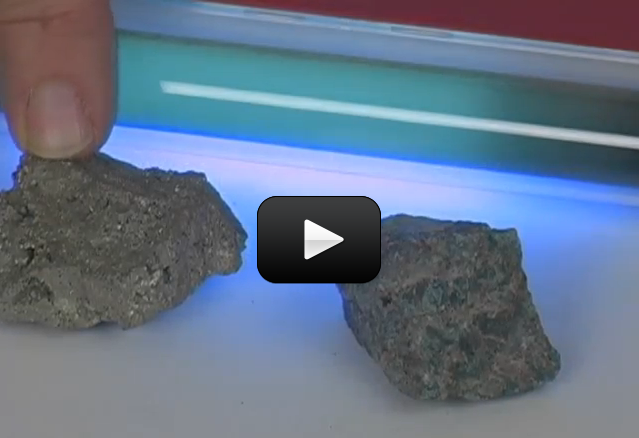Fluorescent minerals emit light when exposed to ultraviolet (UV) light, usually in a completely different color than when exposed to white light. UV is invisible to the human eye, and is the wavelength of light that is responsible for sunburns.
[am4show have=’p8;p9;p30;p57;p79;’ guest_error=’Guest error message’ user_error=’User error message’ ]
Materials:
- Longwave UV light
- Sunlight
- Rock samples (The four samples at the end of the video are: top left is opalite, top right is calcite, bottom left is norbergite, bottom right is calcite & willemite.)
Download worksheet and exercises
Stars, including our sun, produce all kinds of wavelengths of light, even UV. The UV minerals in this lab contain a substance that reacts with light. It takes the UV light from the sun and then re-emits it in a different wavelength that’s visible to us.
When a particle of UV light hits an atom in the mineral, it collides with an electron which makes the electron jump to a higher, more energetic state that is a bit further from the center of the atom than the electron is used to. That’s how energy gets absorbed by an atom. The amount of energy an electron has determines how far from the atom it has to be.
The electron prefers being in its lower state, so it relaxes and jumps back down, and when it does, it transfers a blip of energy away. This blip of energy is the light we see emitted from the UV mineral. This process continues as long as we see a color coming from the mineral under the UV light.
There are two different types of UV wavelengths: longwave and shortwave. Some minerals fluoresce the same color when exposed to both wavelengths, while others only fluoresce with one type, and still others fluoresce a different color depending on which it’s exposed to. Minerals fluoresce more notably with shortwave UV lamps, but these are more dangerous than longwave since they operate at a wavelength that also kills living tissue.
Shortwave UV lamps and lights should only be operated by an experienced adult. Never use a shortwave light when children are around.
Most minerals do not fluoresce, but in the ones that do, there are either small impurities that fluoresce (called “activators”) or the pure substance itself fluoresces (although this is rare). For a mineral to fluoresce, the impurities present must be in just the right amount. For example, red fluorescent calcite from Franklin, NJ, USA is activated by manganese that’s present, but only if there’s about 3% of it in the mineral. If there’s more than 5% or less than 1% manganese, the sample won’t fluoresce at all. It’s the amount and type of the impurities that determines the color and intensity of the fluorescence.
Fluorescence is not a reliable way to identify a mineral, since some samples will fluoresce with different colors even though they are all the same mineral. Fluorescence is used to determine where the mineral came from, since the colors that the minerals fluoresce usually match the original location of the mineral.
Phosphorescence is when a sample glows even after you turn off the UV light source. This is the type of glow you’ll find in “glow in the dark” toys, where the light slowly fades after you turn off the light. Atoms continue to emit light even after the electrons return to their normal energy states. While it looks like seconds to minutes that the glow lasts, some samples have been found to phosphoresce for years using highly sensitive photographic methods. Only a few minerals phosphoresce, such as calcite from Terlingua, Texas.
- Label and number each of your samples and record this on your data table.
- Hold your mineral in the sunlight and record the color in the data table.
- Go inside and turn off the lights. Hold your sample under a longwave UV light and record the colors that you see.
- Complete the data table.
- Minerals that fluoresce under longwave UV:
- Aragonite
- Hackmanite
- Calcite
- Fluorite
- Opalite
- Calcite & willemite
- Tremolite
- Resinous coal
- Wernerite
- Minerals that fluoresce under shortwave UV:
- Aragonite
- Termolite
- Wiollemite
- Opalite
- Chalcedony
- Calcite & willemite
- Talc
- Resinous coal
- Norbergite
- Calcite
Exercises
- What wavelength is shortwave UV? Longwave UV?
- How is fluorescence different from phosphorescence?
- Name two minerals that fluoresce in both shortwave and longwave UV light.
[/am4show]


Yes it sure is!
Aurora, is fluorite a flourecent rock?
Okay, thanks!
-Olivia
You’re right – that’s because there is no audio at those times. We’re just looking at the wavelengths in different types of light. 🙂
And it also goes away at 4 minutes and 30 seconds and comes back 10 seconds later, and then it goes away again 3 seconds after it came back and comes back about 12 seconds later.
-Olivia
The audio goes away at 3 minutes and 47 seconds into the video and comes back at 4 minutes and 5 seconds.
-Olivia